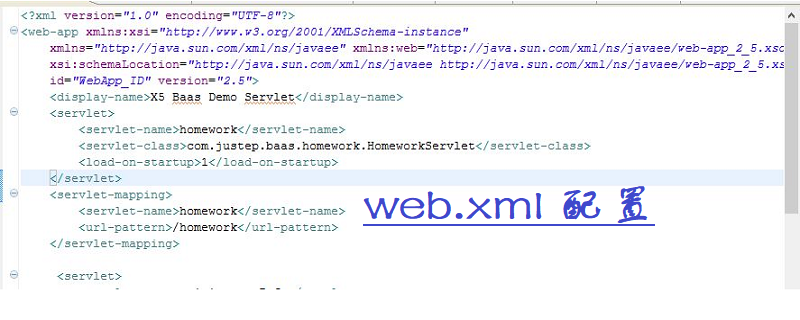Home >Common Problem >What to configure webxml
What to configure webxml
- anonymityOriginal
- 2019-05-06 16:55:403499browse
The web.xml file is used to configure: welcome page, servlet, filter and other configuration files. When your web project does not use these, you can configure your web project without the web.xml file. The tags defined in the web.xml schema file are not fixed, and the schema file can also be changed. Generally speaking, as the version of the web.mxl schema file is upgraded, the functions defined in it will become more and more complex,

That is, there will be more and more types of tag elements, but some are not commonly used. We only need to remember some commonly used ones.
The following example gives the necessary order for all legal elements that can appear directly within the web-app element.
For example, this example illustrates that the servlet element must appear before all servlet-mapping elements. Note that all these elements are optional. Therefore, you can omit an element, but you cannot put it in an incorrect position.
<?xml version="1.0" encoding="UTF-8"?>
<web-app xmlns:xsi="http://www.w3.org/2001/XMLSchema-instance"
xmlns="http://java.sun.com/xml/ns/javaee"
xsi:schemaLocation="http://java.sun.com/xml/ns/javaee http://java.sun.com/xml/ns/javaee/web-app_3_0.xsd"
id="WebApp_ID" version="3.0">
<!-- icon元素指出IDE和GUI工具用来表示Web应用的一个和两个图像文件的位置。 -->
<icon></icon>
<!-- display-name元素提供GUI工具可能会用来标记这个特定的Web应用的一个名称。 -->
<display-name></display-name>
<!-- description元素给出与此有关的说明性文本。 -->
<description></description>
<!-- context-param元素声明应用范围内的初始化参数 -->
<context-param></context-param>
<!-- filter 过滤器元素将一个名字与一个实现javax.servlet.Filter接口的类相关联。 -->
<filter></filter>
<!-- filter-mapping 一旦命名了一个过滤器,就要利用filter-mapping元素把它与一个或多个servlet或JSP页面相关联。 -->
<filter-mapping></filter-mapping>
<!-- listener 对事件监听程序的支持,事件监听程序在建立、修改和删除会话或servlet环境时得到通知。Listener元素指出事件监听程序类。 -->
<listener></listener>
<!-- servlet 在向servlet或JSP页面制定初始化参数或定制URL时,必须首先命名servlet或JSP页面。Servlet元素就是用来完成此项任务的。 -->
<servlet></servlet>
<!-- servlet-mapping 服务器一般为servlet提供一个缺省的URL:http://host/webAppPrefix/servlet/ServletName。但是,常常会更改这个URL,以便servlet可以访问初始化参数或更容易地处理相对URL。在更改缺省URL时,使用servlet-mapping元素。 -->
<servlet-mapping></servlet-mapping>
<!-- session-config 如果某个会话在一定时间内未被访问,服务器可以抛弃它以节省内存。可通过使用HttpSession的setMaxInactiveInterval方法明确设置单个会话对象的超时值,或者可利用session-config元素制定缺省超时值。 -->
<session-config></session-config>
<!-- mime-mapping 如果Web应用具有想到特殊的文件,希望能保证给他们分配特定的MIME类型,则mime-mapping元素提供这种保证。 -->
<mime-mapping></mime-mapping>
<!-- welcome-file-list元素指示服务器在收到引用一个目录名而不是文件名的URL时,使用哪个文件。 -->
<welcome-file-list></welcome-file-list>
<!-- error-page元素使得在返回特定HTTP状态代码时,或者特定类型的异常被抛出时,能够制定将要显示的页面。 -->
<error-page></error-page>
<!-- resource-env-ref元素声明与资源相关的一个管理对象。 -->
<resource-env-ref></resource-env-ref>
<!-- resource-ref元素声明一个资源工厂使用的外部资源。 -->
<resource-ref></resource-ref>
<!-- security-constraint元素制定应该保护的URL。它与login-config元素联合使用 -->
<security-constraint></security-constraint>
<!-- 用login-config元素来指定服务器应该怎样给试图访问受保护页面的用户授权。它与sercurity-constraint元素联合使用。 -->
<login-config></login-config>
<!-- security-role元素给出安全角色的一个列表,这些角色将出现在servlet元素内的security-role-ref元素的role-name子元素中。分别地声明角色可使高级IDE处理安全信息更为容易。 -->
<security-role></security-role>
<!-- env-entry元素声明Web应用的环境项。 -->
<env-entry></env-entry>
<!-- ejb-ref元素声明一个EJB的主目录的引用。 -->
<ejb-ref></ejb-ref>
<!-- ejb-local-ref元素声明一个EJB的本地主目录的应用。 -->
<ejb-local-ref></ejb-local-ref>
</web-app>The above is the detailed content of What to configure webxml. For more information, please follow other related articles on the PHP Chinese website!

